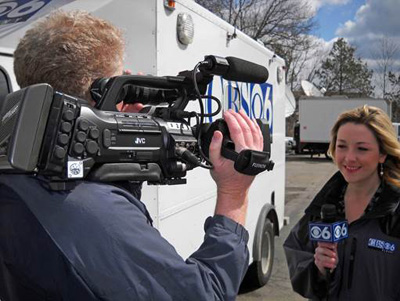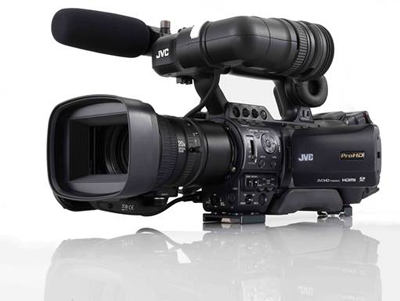Sinclair Chooses Cellular Newsgathering Without a Backpack
Sinclair Broadcast Group, owner of more TV stations than any company in the country, is leveraging the benefits of video transmission over cellular IP networks while also expanding the reach of its newsgathering capabilities with the addition of JVC's GY-HM890 ProHD shoulder-mount camera. The camera's built-in streaming engine allows live HD transmission from the field. The company has ordered 70 of the cameras for its local news operations.
Indeed, while dozens of stations around the country have chosen ENG systems that include a camera tethered to a small streaming encoder housed inside a backpack or other portable configuration, Sinclair sees value in the small size and portability of a single camera/transmitter. At less than $10,000, it's also a less costly option.

Sinclair stations like WRGB-TV, in Albany, NY, are slated to take delivery of new JVC cameras with live streaming capability soon. "The camera provides built-in live HD streaming, which is the game-changing feature we've been waiting for in a full-sized camcorder," said Del Parks, senior vice president of engineering and operations, Sinclair Broadcast Group. "JVC has delivered, and we look forward to partnering with them for future product development."
The recent purchase is part of a company-wide initiative to outfit all of its stations that produce news with GY-HM890 cameras.
"JVC's new GY-HM890 provides us with innovative features that save on operational costs without sacrificing quality," Parks said.
Instead of a backpack-style system, the GY-HM890 offers a USB port that accepts a Verizon 4G LTE modem as a dongle. The camera also offers Wi-Fi capability, allowing news crews to use a local hotspot or portable Wi-Fi card to get the news back to the station (or broadcast live). The camera can also be used to send completed files via FTP transfer—a feature that camera suppliers such as Canon, Panasonic and Sony also provide on their products.
To keep the camera compact, JVC has added a second IP codec that uses streaming technology from a company called Zixi to generate a robust stream at multiple bit rates.
The drawback appears to be being limited to a single carrier, when other systems offer transmitter cards for multiple carriers in a single backpack unit. What if a location has poor service on one carrier?

The GY-HM890 HD camera features 3 CMOS sensors, an interchangeable Fujinon 20x autofocus zoom lens, and dual SDHC/SDXC card slots for recording HD or SD footage in a variety of native file formats. "Three years ago, when 3G was the predominant network, reliability was not that great," said Dave Walton, marketing manger at JVC. "With 4G LTE now much more widespread, and the addition of error-correction algorithms, we're getting great results in a variety of environments. It won't work everywhere—and there's no guarantee with backpack systems either—but reliability is better than you'd expect."
JVC's Advanced Streaming Technology provides error correction, bandwidth shaping and real-time feedback of streaming status to help ensure a reliable signal transmission.
"If a broadcaster is putting 16 cameras into operation, they can't afford to buy 16 backpack units to go with them because it becomes too expensive," Walton said. "With our new cameras, every operator has the ability to stream live."
With the GY-HM890 (and GY-HM850, which will be demonstrated at the NAB Show in Las Vegas), Walton sees stations working on a shared data plan to save money and having the ability to operate the camera remotely via an Internet connection. Each camera gets an IP address that can be leveraged with an optional JVC ProHD Broadcaster package (server and software for $1,995). The package functions as a matrix switcher and an ingest recorder for all of the station's IP cameras. Smartphones can also be programmed into the system. (Stations can subscribe to a cloud-based solution from JVC as well, although they still need an Internet connection and a physical decoder at the station.)
"Using a dedicated server in their facility, a station can now point all of the cameras to that one server," Walton said, adding that JVC is working on new features that will enable the ProHD broadcaster to automatically dedicate more bandwidth to the camera that needs it the most. "The station staff can then look at the bit rate and packet loss and make adjustments for each camera remotely as required."
An engineer at the station can look at all of the cameras in the field and switch live to whichever one has the best shot. Walton said they tested the system by sitting at JVC headquarters in New Jersey and zooming in the lens on a GY-HM890 camera in California.
The GY-HM890 HD camera features three CMOS sensors, an interchangeable Fujinon 20x autofocus zoom lens, dual SDHC/SDXC card slots for recording HD or SD footage in a variety of native file formats, and HD/SD-SDI pool feed input (not on the GY-HM850), and four-channel audio with two XLR mic/line inputs. The GY-HM890 is compatible with JVC's range of components and accessories, and can be configured as a studio camera with an optional buildup kit that includes a 68-pin connection that accommodates JVC fiber or multi-core camera modules.
"This idea of remotely controlling cameras in the field via IP is the next step in newsgathering," Walton said. "I think Sinclair understands that and is making a commitment to its future. There's a lot of directions broadcasters can go, and there's not any one solution that's perfect, but if you work in an area that has really good Wi-Fi coverage, a station can program the camera to lock into the hotspots, wherever they may be, and be assured of good signal coverage."
Based in Hunt Valley, Md., Sinclair owns or operates 149 stations in 71 markets. With 85 stations producing news, the company already has almost 100 JVC ProHD cameras in the field, including GY-HM790 shoulder-mount and GY-HM650 handheld models. Deliveries of the GY-HM890s are expected to begin next month, with several cameras slated for WOAI and KABB in San Antonio (DMA #36) and WJAC in Johnstown, Pa. (DMA #103).
Get the TV Tech Newsletter
The professional video industry's #1 source for news, trends and product and tech information. Sign up below.
